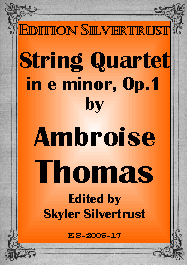Presents
Ambroise Thomas
String Quartet in e minor, Op.1
 Today, Ambroise Thomas (1811-1896)
is only remembered as the composer of the opera Mignon, one of the most
successful French operas written during the last half of the 19 century. He was
born in the French city of Metz where his parents were music teachers. They
prepared him to become a musician and by age 10 he was already an excellent
pianist and violinist. In 1828, he entered the Paris Conservatory while at the
same time continuing his piano studies privately with the famous virtuoso pianist Kalkbrenner. In
1832, he won the Conservatory's prestigious composition prize, the Prix de Rome, which allowed him to
travel to and study in that city for a year. He took with him a love for Mozart
and Beethoven but once in Rome became an ardent admirer of the Italian cantilena
and melodic tradition. It was during his Italian sojourn that he wrote all of
his chamber music--a piano trio, a string quintet and a string quartet.
Today, Ambroise Thomas (1811-1896)
is only remembered as the composer of the opera Mignon, one of the most
successful French operas written during the last half of the 19 century. He was
born in the French city of Metz where his parents were music teachers. They
prepared him to become a musician and by age 10 he was already an excellent
pianist and violinist. In 1828, he entered the Paris Conservatory while at the
same time continuing his piano studies privately with the famous virtuoso pianist Kalkbrenner. In
1832, he won the Conservatory's prestigious composition prize, the Prix de Rome, which allowed him to
travel to and study in that city for a year. He took with him a love for Mozart
and Beethoven but once in Rome became an ardent admirer of the Italian cantilena
and melodic tradition. It was during his Italian sojourn that he wrote all of
his chamber music--a piano trio, a string quintet and a string quartet.
The String Quartet in e minor, though numbered as his opus 1, was by no means his first work. To begin with, the Prix de Rome was a composition prize and Thomas had won it based on his composition of a cantata. He had written quite a number of other works even before entering the Conservatory. The quartet was his first work, after his student days, in his opinion worthy of an opus number. This light but brilliantly written quartet, dating from 1833, shows how well Thomas had assimilated the musical language of the Italian vocal and operatic style and one can clearly hear the influence of Rossini and Paganini, two of its leading advocates at that time.
In the first movement, Allegro moderato, the lovely but brooding main theme is first presented as a duet between the cello and first violin but then all of the voices join in its development. Short stormy episodes periodically punctuate longer, cantabile sections. The second movement is marked Menuetto, but the music, characterized by fast descending and then ascending passages, is closer in feel to a scherzo than a minuet. The lovely trio section (heard in our soundbite), is a waltz in which the viola and then the cello are given long singing passages. Verdi, who knew Thomas' music well, must surely have borrowed this idea for his own quartet as the trio section to his quartet so closely resembles what Thomas did here. The third movement, Andante, is clearly written in an operatic fashion. Each voice shares the beautiful theme in short responsions. In hearing the thematic material of the toe-tapping finale, Allegro vivace--Allegretto, one might well guess the composer was Paganini. Here, brilliance comes to the forefront and especially in the exciting conclusion. There is very little like this quartet in the literature and of its kind, it is clearly first rate. Enjoyable for amateurs but strong enough for professionals looking for a lighter work to fit between weightier pieces.
Out of print for over 130 years, our edition, based on the original Richault edition of the 1830's, has been entirely reset and carefully edited by Skyler Silvertrust, who corrected the many errors which appeared in the original and subsequent reprints.
Parts: $29.95
Score & Parts: $36.95